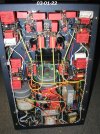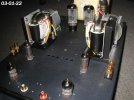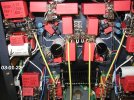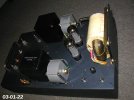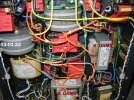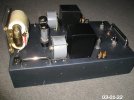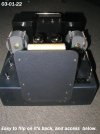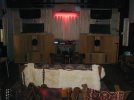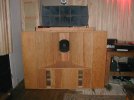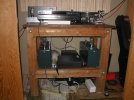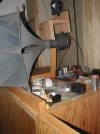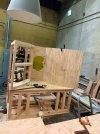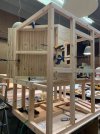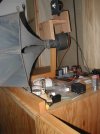The Last “ One Percent ” …............ Part 1, of 2 Parts …..............03-05-22
In the heading of the second post of
this build thread, on 03-03-22, it was mentioned the 6005 amp / Chassis #2, was 99 percent finished.
This post relates to the
last one percent needed,....... to finish that build.
There remained
two different tasks :
Task ONE, orientate by ear all the five AC connections, to have synchronized, best sounding AC waveform polarities.
Task TWO, build a bottom-of-the-chassis cover plate which will also act as an Isolation Platform.
This post represents TASK ONE, ( the five different AC orientations, their synchronization and optimizing. )
- - - - - - - - - - - - - - - - - - - - - - - - - - - - - - - - - - - - - - - - - - - - - - - - - - - - -
Every tube audio amplifier, manufactured or DIY, “ ideally” should address the AC polarity feeds of these following five circuitry areas :
1) AC power cord input to the amplifier. If ( hopefully ) using a grounded 3 wire power cord, are the “ hot and neutral ” connections optimized , AC polarity wise, so the amp sounds it best on music playback ???
THE
ABOVE, may be considered as a gross and minimal first area to address.
THE
BELOW, addresses the INTERNAL optimizations of the amplifier, AC polarity – wise:
2) The
Input tube's AC filament feed orientation.
3) The Main Power Transformer's
High Voltage Secondary winding.
4) The
Rectifier tubes' AC filament wiring.
5) The
Output tube's AC filament wiring
- - - - - - - - - - - - - - - - - - - - - - - - - - - - - - - - - - - - - - - - - - - - - - - - – - - - - -
There are two methods I can think of to optimize AC polarity. One can look at waveform directions on a scope, and get all the above five AC waveforms to move in a similar direction, simultaneously.
One AC polarity should not 180 degrees “ buck or skew ” any of the others, which is audible in a high performance SE tube amplifier.
I don't trust this first approach, by itself. For example, what if the waveforms are all moving simultaneously, but exactly 180 degrees out of what sounds ideal !!!
I build DIY SE amps to try to make them better in sound, from what ever I can purchase manufactured. The “ sound ” is the end criteria ( along with reliability ). So what about determining optimum AC polarity a second way. Why not determine precisely how
each AC - fed circuit sounds it's best, in its 180 degree hook up orientation, when operating in the amplifier???
This approach only takes a soldering iron, and two decent clip lead wires ( to reverse phase ) and music to play ( consistently as a source ). This seems most fool proof to me, and it is precisely how I have been optimizing AC in SE DC amp builds since mid 2019. Count me...... “ all in ”.
- - - - - - - - - - - - - - - - - - - - - - - - - - - - - - - - - - - - - - - - - - - - - - - - -
To prepare a newly built amplifier, for by-ear AC orientation, it is best to break it in first on music playback for a minimum of 75 to 100 hours. I did a “ silent ” break in of the finished Chassis #2 over the past week or two.
( From previous experiences, the Main Hammond 159ZA power supply chokes, the E.H. 5U4GBs, and the RW-20 R-Core Output Transformer windings all require at least 75 hours of break in ).
A vintage modest Magnavox CD player, which has a
repeat function, continuously played full bore volume into the new Chassis #2 amp, with a low-cut CD music source. Instead of attaching loudspeakers, I placed 15 Ohm 5 Watt power resistors, across both channel's Cardas Speaker Binding posts. This properly loads the music-driven Softone RW-20 output transformers. This set up can run day and night silently, even while I am asleep in the evening.
Wonderful. Many
off-and-on cycles are interspersed, with time to allow the unit to cool down . By this past Friday evening, 03-04-2022, the amp was broken in enough to evaluate critically, those five above-mentioned AC orientations by ear.
- - - - - - - - - - - - - - - - - - - - - - - - - - - - - - - - - - - - - - - - - - - – - - - - -
The test-set-up has been previously discussed. Pioneer's older top-of-the-line BPD-09FD Blu Ray player. A single set of RCA interconnects, directly feeding the amp under test, with the Player going into the amp with a full-bore music signal. That is right. No attenuator, or a second set of RCA interconnects, with various connection and cable and parts degrades, to get in the way of feeding the best possible / repeatable signal into the amp for critical music evaluation. KISS. It plays back loud, but the ALTEC VOTTS are not stressed with low Watt amps. I have no adjoining neighbors to worry about....... loud-sound-disturbing-wise. Good.
- - - - - - - - - - - - - - - - - - - - - - - - - - - - - - - - - - - - - - - - - - - - - - - -
As a much needed complete mental
change-of-pace, I decided to NOT use “ Steve Clarke, Solo Drums ” as the AC orientation music source. Instead, I chose Mark Knopfler / Dire Straits / Brothers In Arms, by Warner Brothers 114734 D, circa 1985. Boutique Hi Fi stores in the USA use this CD often. They love to demonstrate Magneplaners, and to sell costly kilowatt KRELL power amps to the public. LOL.
OK, here we go :
AC TEST ONE...... the POWER CORD orientation :
The new 6005 amp is totally unknown as to AC optimization here, so one has to make a gross guess, as to what 180 degree AC feed orientation sounds best. I used a cheap ( under a dollar ) 3 into 2 AC adapter, with its wider ground prong filed to be narrower. It could be inserted into my wall socket, either polarity, to obtain 180 degree changes. I went back and forth about four or five times, until I was satisfied, that one AC plug-in orientation sounded the best overall.
No, I certainly was not looking for lowest hum with a DMM. I wanted to discover what orientation overall sounded the best to me on music. For the rest of my testing, this polarity stayed CONSTANT.
AC TEST TWO - the INPUT tube's AC filament excitation :
The Input tube is the most important stage of the amp to optimize. Two reasons, it has the most gain ( in a DC two stage amp ) and any fidelity / resolution loss in the first stage of music signal amplification, is impossible to make up in later stages .
Notice from prior post photos, all AC filament wiring is twisted gray and white colored ( 16 AWG m22759/11 ) wiring. I carefully solder the same colored wires to the same tube socket pin numbers, for each channel. All I did was unsolder the gray and white wire's connections, to the filament transformer's leads, and use two custom 7 inch long M22759/11/14 AWG clip lead wires, with pure copper alligator clips, to swap the AC feed by 180 degrees.
Good news, “ So Far Away ”, Cut #1, played better, sounded better, right from the start. It played louder and with better colors and harmonics. Resolder the gray and white wires to the new and better AC orientation, and go on to the next area to analyze. Happier. A good start.
AC TEST THREE - the Main Power Transformer's SECONDARY High Voltage WINDING :
This is a large custom Shilchar 320 VA R-core Power Transformer. Unsolder the two high voltage secondary leads and clip lead re-orientate them, 180 degrees AC flipped.
Be very careful here, with lead dress and clip lead connections, as we are dealing with highly lethal 800 Volts of AC across this winding!!!!! Check twice before power up. Have your wits about you.
From the very first note played on Cut #2, “ Money for Nothing ” there was an easy to hear improvement. The amp played the music louder, more dynamic, and slightly more defined. There is a fabulous early guitar solo, stage left, and it was better now - than all the prior AC steps.
But the entire presentation was not quite right, not quite believable yet.. The guitar solo seemed to lack “ drive ” of the bottom portion of the guitar's body,... drive into the recorded space, and into my room. The high end of the guitar still seemed to predominate
ever so slightly . The opening bass chords on Cut #1, “ So Far Away”, however were much improved...we were getting there.
Resolder High Voltage Secondary leads to their new 180 degree different orientation, and go on.
At this point in time, I had the following thought : “ I wish the nice audiophile Hong Kong client who will get this Chassis #2 amp, and Mr. Hari Iyer, were sitting in the room with me, to be able to hear and appreciate these subtle, cumulative changes. It would have been a great listening experience - for them both. All unmistakable.
AC TEST FOUR, the TUBE RECTIFIER FILAMENT wiring :
Same deal, unsolder the original two leads, clip lead and reverse polarity these two leads. This is a 5 VCT at 6 Ampere power transformer, custom Shilchar R-core, to power dual 5U4GB rectifier tube filaments.
Ohh my Goodness !!!! From the very first notes of “ Money For Nothing “, Cut #2 , the amp sounded appreciably better again !!! It played louder, with more dynamics, noticeably more energy into my listening room, in the X,Y, and Z axis. The opening bass notes in “ So Far Away ”, Cut #1, sounded AOK for the first time ( I love the ALTEC 515B 15 inch woofers ) , and totally believable to me. Guitar plucking that was in the background, and previously “ lost in the mix ”, was now being heard as distinct , on time, and defined. Resolution of subtle background accompanying voices, was now more distinct and better placed in all axis. The entire audio system played bigger, with more dynamic contrasting in the room.
Hey dear Forum friends, this is getting wild. There is a 50-50 chance that an AC connection is in best sounding phase. Now, we are at 80-20, after four of five AC orientation swaps !!
The wild guitar solo in Cut #2 showed signs for the first time, of proper harmonics, and energy, including finally,
the lower body of the instrument. It still wasn't quite as good as I heard it with amp/chassis #1, but it
really was getting there.
By this time, the listening session was long, and getting late in the evening. I thought of retiring for the night. But the
unknown outcome of “ What would happen ” at TEST # 5, the FINAL AC orientation test, would have never allowed me to go to sleep. Any audiophile and DIY amp builder, worth their salt, would continue.
OK. OK. I soldered in the tube rectifier filaments to its new ( reversed and better sounding ) AC phase, and went on to unsolder and swap the last connection, the Output tubes AC powered filaments. Clip leaded them in 180 degrees opposite.
AC TEST FIVE, the OUTPUT TUBES' AC filament excitation.
Ohh my goodness again, from the opening note, the system played from the bottom up, cleaner, louder, and with more dynamics. Music resolution, definition, harmonic structuring, was “ off the scale .” The speakers disappeared in my living room, and the power and dynamic contrasting of the music was wonderful to experience.
Realize, this amp has a total of 12 Ohms DCR to the Finals tubes for B+ inductive filtering, and dual rectifier tubes, GTO capacitors, and much use of 12 AWG Mil Spec wiring. These corrected / optimized AC orientations, in all five circuit locations, allowed me to achieve a great and permanent music listening performance improvement, to be enjoyed on my nice friend's Beauhorn Virtuosos.
- - - - - - - - - - - - - - - - - - - - - - - - - - - - - - - - - - - - - - - - - - - - - - - - - - - - -
- - - - - - - - - - - - - - - - - - - - - - - - - - - - - - -- --- - - - - - - - - - - - - - - - - - -
Imagine starting this AC test procedure with a 50 -50 chance of some of the AC connections being ideal, and discovering that it was a 100% to 0%..... actual result. All were in need of swapping. ( Note : I am not sure of the very first test result ).
This overall amplifier improvement, with my type of circuit, and power supply, was substantial. F.M. Hari Iyer, I suggest for you to do your KT88 DC amps...... this same precise way .

At no time during this Chassis #2 testing, did I have the Softone RW-20 steel transformer covers mounted over the output transformers. It was an audible degrade, easily detected on my system. At no time during this testing, did I allow the two speaker lead polarities touch each other, in the distance between the new 6005 amp, and the speaker crossovers. They were suspended in mid-air. ( No polarity touch, no polarity twisting, eliminates loss of high end music information ).
One point I would like to make is, no one would get this performance, from this type of SE DC amp, unless they did this “ last 1 % ”, …....to finish the build properly !!
Another point. No manufacturer I am aware of, does all of this type of optimization, and I have never seen or heard a discussion among my fellow DIYer amp builders over the decades, about this procedure. Of course, we must all
realize, I have not on-line researched this specifically, and I am certainly not privy to all that happens in tube amp builds on Planet Earth.

My knowledge of all of this comes directly from my mid 2019 KT88 SE DC amp build, where I was confronted with the use of multiple power transformers. I am self - taught. Any sincere questions, fire away !!
A++ to anyone who has read all of this post.
I hope, in future years, and for a few future DIY tube amp builders, that this approach does not get lost .
Jeff




